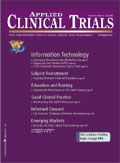EU Questions Get Real EU Answers
New Q&A guidance attempts to clear up any confusion about new Directive rules.
The European Union has—yet again—updated its informal guidance on good clinical practice. It's part of what has become a never-ending process: keeping its rules abreast of new scientific, technological, and commercial developments, and keeping practitioners abreast of the evolving rules. The latest official contribution is a question-and-answer sheet aimed at providing simple answers to some of the obvious questions that are neglected or unclear from the legal texts alone.

Peter O'Donnell
One of the striking features of this update is an algorithm to help define when development work on a product comes under the rules governing clinical trials of medicinal products. The chart is a model of clarity on what does not fall within that scope. If it is not a substance or combination presented as having properties for treating or preventing disease in human beings, if it does not function as a medicine, and if it is not an active substance in a pharmaceutical form, then the envisaged activity is not a clinical trial on a medicine.
So far so good. And the next step is pretty straightforward too. If you are only administering human whole blood, cells or plasma, tissues (with the exception of somatic cell therapy products), food products, cosmetics, or medical devices, the activity is not a clinical trial on a medicine.
Filtering out
But then, inevitably, it gets more complicated. If the plan is not already excluded by the first steps, then a further series of questions needs answering. A critical criterion is the effect you are looking for in the medicine. So if the aim is to discover, verify or compare its clinical or pharmacological effects, identify, verify, or compare its adverse reactions, or study its absorption, distribution, metabolism, or excretion, you may well be in trial territory and need to check against the next qualifying criteria. If you are not aiming to ascertain, verify, or compare the efficacy or safety of the medicine, then you are not required to take account of the clinical trial directive. But if you are, your activity goes through to the next elimination round.
If the product has a marketing authorization in the member state where the activity is planned, and if it is prescribed in line with its authorization, you are still outside the scope of the directive—as long as some other conditions are also met. The assignment of patients involved to a particular therapeutic strategy has to fall within current practice and not be decided in advance by a clinical trial protocol, and the decision to prescribe a particular product must be clearly separated from the decision to include the patient in the study. There must be no diagnostic or monitoring procedures of patients in the study, other than those that are applied in the course of current practice, and epidemiological methods must not be used for the analysis of the data arising from the study. In these circumstances, the activity is a noninterventional trial, which is outside the scope of the directive. But in every other case, you are subject to the directive.
Filling in the blanks
There are plenty of valuable footnotes too. The technical terms employed ("substance," "food," "cosmetic," and so on) are helpfully defined, and additional explanations are incorporated. For instance, it is made clear that assignment of patients to a treatment group by randomization cannot be considered as current practice; doing this will tip your study into the domain of clinical trials.
This hands-on type of guidance should be valuable to many who are not sure whether they have to take account of the directive—and its onerous requirements. Clinical trials included in any marketing authorization application in the EU are required to be conducted in accordance with GCP, with its quality standards for designing, recording, and reporting.
And for those who are conducting or planning clinical trials, the Q&A offers some practical advice too, filling in some of the gaps as the new EU rules in this area come into effect. For instance, it spells out how sponsors are supposed to cope with the situation where member states are late in implementing the new rules (basically, sponsors have to make sure their trials in those countries meet international standards of GCP if they want them to be considered in an authorization application).
It widens the understanding of how references in the new legislation should be interpreted: a "sponsor" does not need to be located in an EU member state, for instance—although they must have a legal representative in the EU. A non-EU firm can have one central legal representative in the EU for all its trials—but that representative must also accept all responsibility for civil and criminal liability arising out of trial conduct.
The investigator and the sponsor may be the same person; and the sponsor can legitimately delegate duties such as compiling documents for applications to ethics committee or competent authorities, monitoring, or pharmacovigilance reporting. And—to the relief of many academic institutions—it is still possible for industry to supply trial products for free or scientific support without necessarily jeopardizing a trial's status as noncommercial (and therefore with some significant easing of a number of GCP requirements).
On issues such as validation of an application for an ethics committee opinion or appeals against it, on how soon a multinational trial can start in each member state, or on how to handle a change of site or principal investigator, the guidance gives concrete answers. It's a refreshing (and rather unusual) approach in the EU, which more usually tends to leave everyone to sort out the real meaning of its often tortuous legislative texts.
Another first for another rule
Meanwhile, the EU's complex machinery has made the first step toward granting the first-ever conditional marketing authorization under its new rules. At the end of April, the Committee for Medicinal Products for Human Use—the top scientific committee in the European Medicines Agency—recommended granting this new type of authorization to Pfizer's Sutent (sunitinib), in two specific cancer indications.
This new type of authorization is intended to allow limited use of a promising product even before all of its trials are completed. The trials to date on Sutent have shown enough evidence of efficacy to justify its early release.
The benefits in patients with unresectable and/or metastatic malignant gastrointestinal stromal tumor are based on a double-blind, placebo-controlled randomized trial, which showed an increased time to progression and overall survival compared to placebo in patients who were not candidates for treatment due to resistance or intolerance.
The benefits in patients with metastatic renal cell carcinoma are based on the objective response rate observed in two single-arm, open-label trials in patients after failure of cytokine-based therapy. Adverse events included fatigue, hypertension, neutropenia, gastrointestinal disorders, and increased lipase.
The agency's experts judged that comprehensive clinical data about the efficacy of Sutent had not been provided, but that there is nonetheless a favorable benefit-to-risk balance sufficient to justify a conditional authorization.
The precise conditions for the use of this product will be spelled out, and the sponsor's obligations will be reviewed annually by the agency.
The decision follows the entry into force of new EU rules on conditional approval, which are designed to help speed up patients' access to medicines for seriously debilitating or life-threatening diseases for which there are no other treatment options. It's another example of how the EU is trying to make its own safety rules work better—and how, to a limited extent, it is succeeding.
Sutent is itself already a beneficiary of another recent EU scheme—the orphan medicines program, which has been providing additional incentives for rare-disease treatments for five years now. Sutent received its designation as an orphan product in March 2005 for both indications, and the next stage will be a formal EU decision on the basis of the experts' opinion.
Peter O'Donnell is a freelance journalist who specializes in European health affairs and is based in Brussels, Belgium.

FDA Fast Tracks Johnson & Johnson’s Nipocalimab for Fetal Neonatal Alloimmune Thrombocytopenia
March 27th 2024Johnson & Johnson is moving forward with a pair of Phase III trials of nipocalimab to reduce the risk of fetal neonatal alloimmune thrombocytopenia in alloimmunized pregnant patients.